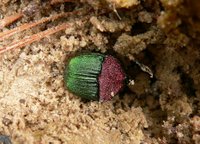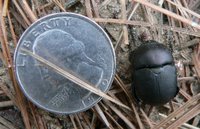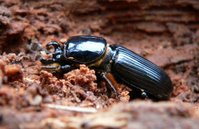Beetles and Scorpions

Each time I go out into the field I never return empty-handed and today was no exception. A rainbow scarab beetle (Phanaeus vindex) appeared hovering low over the ground and landed near where I stood. The colors of this beetle are stunning. Brilliant green and purple hues give it the appearance of a jewel. No wonder the ancient Egyptians fashioned some of their jewlery resembling this beautiful insect. Minutes later another beetle, a black earth-boring dung beetle comes flying along and lands near the other. Both seem to be attracted to a small mound of canine scat (coyote?) that's nearby. Both of these beetles not only consume "dung", but they also excavate tunnels in it where the female lays eggs and upon hatching the larva feed on the dung until fully developed. They both play an important role in not only the degredation of animal wastes, but are also beneficial to the soil.

As I continue my walk down the dirt road I decide to cut off into the woods and hop upon a fallen tree stopping momentarily in the quietness to listen for bird chatter. As I stepped off the end of the rotted log my foot caught its edge and pulled away a piece of it revealing narrow tunnels that had been haphazardly bored into the disintegrating timber. I pulled away some of the porous wood exposing a pair of passalus beetles (Odontotaenius disjunctus). Hmmm.....must be beetle day. Also known as a "Betsy" beetle, one
 began hissing, which they do by rubbing their wings against their abdomen when accosted. Quite harmless they are also beneficial in that they help by recycling old logs. They live in colonies in these tunnels where they rear their young.
began hissing, which they do by rubbing their wings against their abdomen when accosted. Quite harmless they are also beneficial in that they help by recycling old logs. They live in colonies in these tunnels where they rear their young.With a stick I probe into another area of the exposed tunnels and see what at first I think are the legs of some type of spider. I continue to gently force the stick and out comes something totally unexpected- a pair of striped bark scorpions (Centruoides
 vittatus). It is the most common of scorpions found in Texas' deciduous and pine forests and are known to be agile climbers hiding under rocks, logs, and loose debris. Their venom is of low toxicity, but due to the sharp pain, severe discomfort and the not knowing of other ways I might react if stung (some can have severe allergic reactions) I made no attempt to pick it up. Duh....I made a decision awhile back not to pick up poisonous snakes and this also applies to any other animal, insect, or whatever that has a pointy bodypart that injects venom.
vittatus). It is the most common of scorpions found in Texas' deciduous and pine forests and are known to be agile climbers hiding under rocks, logs, and loose debris. Their venom is of low toxicity, but due to the sharp pain, severe discomfort and the not knowing of other ways I might react if stung (some can have severe allergic reactions) I made no attempt to pick it up. Duh....I made a decision awhile back not to pick up poisonous snakes and this also applies to any other animal, insect, or whatever that has a pointy bodypart that injects venom.Labels: beetles, passalus beetle, rainbow scarab, scorpions



